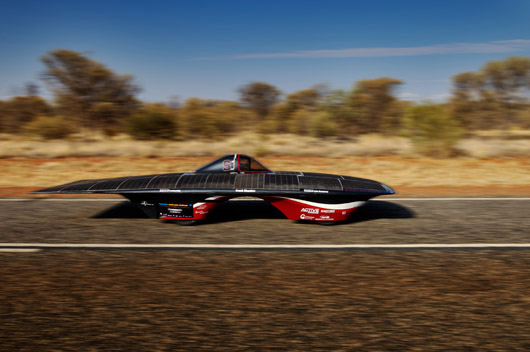A.bc
In Australia, sulle tracce di Chatwin 20 anni dopo Le Vie dei Canti
Palazzo delle Esposizioni, Roma
A.bc
In Australia, in Chatwin's footsteps 20 years after The Songlines Palazzo
Delle Esposizioni, Rome


Se
c’è una cosa che abbonda, da queste parti, è il sole.
Se c’è una cosa che manca, è il traffico. Pochi pericoli,
a parte autisti stanchi o animali vaganti. Forse per questo l’organizzano
qui. Da vent’anni, ogni due anni, il continente è attraversato
da una delle corse più singolari del mondo. 2999 km, da Darwin
ad Adelaide, lungo la Stuart Highway. Solo per veicoli a energia solare.
Monoposto ricoperte da pannelli solari che sembrano uscite da un film
di fantascienza, in realtà prodotti sofisticati dei laboratori
di università e aziende. Ricerca applicata di energia sostenibile.
Scenario futuribile in ambiente primordiale. L’incontro con le solar
car, risalendo la Stuart, è surreale. Attorno il solito piatto
nulla ocra e rosso, qualche albero, un paio di auto e camion ogni dieci
minuti. Poi appaiono loro. Aerodinamiche, lucenti, silenziose. Quando
sfilano accanto senti solo il fruscio dell’aria spostata. Si corre
di giorno, con più di 40 gradi e velocità che sfiorano i
150 kmh, anche se quest’anno si è dovuto fare i conti con
l’introduzione nel Northern Territory del limite di 130 kmh (prima
non esisteva e si favoleggia ancora di sfide a chi tirava su per ultimo
il piede dall’acceleratore). Al tramonto, stop. Ci si accampa fino
all’alba, il sole riappare e si riparte. Per la cronaca ha vinto,
per la quarta volta consecutiva, l’olandese Nuon Solar Team della
Delft University of Technology, a una media di 90,87 kmh. Un solo incidente,
400 km a sud di Alice Springs, quando la macchina della blasonata Stanford
University è finita fuori strada, tra canguri ed eucalipti, per
il banale scoppio di un pneumatico. Pilota illeso, pannelli distrutti,
arrivo al traguardo su un road train. Una variabile sottostimata dagli
ingegneri californiani, ha commentato il giornale locale
If
there is one thing this place abounds in, it's the sun. If there is one
thing missing it's traffic. Few dangers, apart from tired drivers or wandering
animals. Perhaps it is for this reason that it is organized here. Every
two years, for twenty years, the continent has been crossed by one of
the most unique world race. 2999 km, from Darwin to Adelaide, along the
Stuart Highway. Only for solar energy vehicles. Single-seat covered with
solar panels that seem to come from a science fiction film, actually products
of sophisticated laboratories of universities and companies. Applied research
for sustainable energy. Futuristic scenery in primordial environment.
The encounter with the solar cars, driving back along the Stuart highway,
is surreal. All around the usual flat 'nothing' ochre and red, some trees,
a couple of cars and trucks every ten minutes. Then they appear. Aerodynamic,
shiny, silent. When they parade through the road you feel only the rustle
of moved air. They run during the day, with more than 40 degrees,at a
speed of nearly 150 kmh, although this year it has been necessary to comply
with the introduction in the Northern Territory of the lspeed imit of
130 kmh (before this there was no limit and there are still tales about
challenges on who took his foot off the acclerator last). At sunset, they
stop. They camp up until dawn, when the sun reappears and they start again.
For the record, for the fourth consecutive time, the Dutch Nuon Solar
Team of the Delft University of Technology won, with an average speed
of 90.87 kmh. Only one accident, 400 km south of Alice Springs, when the
machine of the titled Stanford University went offroad, between kangaroos
and eucalyptus for a banal blow-out. Unharmed pilot, destroyed panels,
eventual arrival at the finishing line on a road train. An underestimated
variable by Californian engineers, the local newspaper commented on